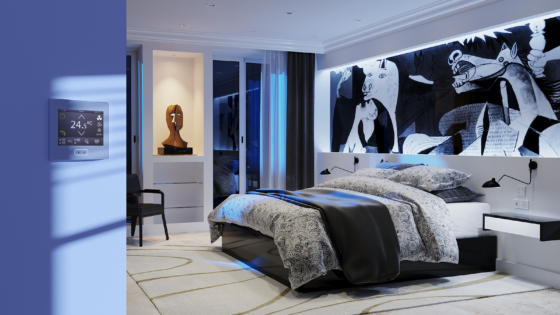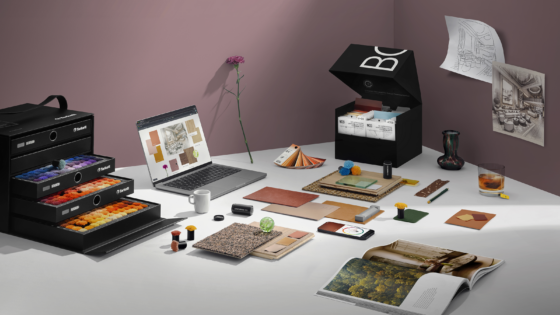Ahead of Hotel Designs LIVE – where GROHE are sponsoring the session “The revival of smart tech post-pandemic” – Hotel Designs catches up with Karl Lennon, Director of Architecture & Design Accounts at GROHE…

Tomorrow, in an engaging panel discussion, Hotel Designs LIVE will explore the revival of smart tech post-pandemic.
Ahead of putting the spotlight back on technology, we catch up with the session’s sponsor, GROHE, to understand how sustainability and technology can work together to create a more meaningful hotel design scene.
Hurry! you have until 10am (BST) today in order to secure you virtual place in the audience for Hotel Designs LIVE. Click here to participate.
Hamish Kilburn: GROHE has consistently been raising the sustainability bar in the hospitality sector for many years now but what’s one thing they are doing that sets them apart?
Karl Lennon: Several years ago, we began our journey into 3D printing and exploring how the growing use of this technology could be applied within bathroom design. Then in March 2019, we unveiled our Icon 3D tap range, a collection of 3D printed taps produced by printing metal using a powder bed laser melting process, a unique material developed by our R&D team. In terms of sustainability, it sees us starting to move away from a make-take-waste model and begin the shift towards operating within a more circular economy. Also, 3D printing allows us to create visual spectacles and masterpieces that just simply wouldn’t be possible with traditional manufacturing methods. We completely pared back on the design of our Icon 3D taps, incorporating design details such as ultra-thin profiles and hollow interiors that would not only push the barriers of bathroom product design but significantly reduce the amount of material required in the manufacturing process too.
Meanwhile, we’re also channelling our innovation back into the hospitality, architecture and design industry with our RIBA-approved CPD programmes. We cover topics such as 3D printing and water-saving to give tangible solutions and help hoteliers and designers realise the potential for these products in their market. I look forward to sharing more on the Icon 3D in our product watch tomorrow!
Image caption: GROHE Atrio Icon 3D | Image credit: GROHE
HK: How will the pandemic impact consumer’s relationships to wellness areas within hotels?
KL: As with many areas of the hotel experience, we will of course see more movement towards touchless activation of products within wellness zones, especially as these are public areas with higher footfall. The likes of infra-red sensors for various touchpoints will become commonplace but this should only enhance the experience and complement that desired sense of wellbeing and “switching off” for guests. This technology is already familiar to most of us, namely through public bathrooms, but expansion is likely to occur across almost all areas of a project. Even some homeowners will be looking to implement touchless operation into areas of their homes so there will be a greater expectation that these developments are in place when visiting a hotel or wellness facility. However, really only time will tell! This is a constantly unfolding situation and one we are learning about and adjusting to everyday so I think we are still finding our path for the future.
Image caption: Icon 3D printing design process | Image credit: GROHE
HK: Are there any exciting projects championing sustainability that you’ve worked on recently?
KL: We see more and more now that hotel operators that we are working with across the globe have made strong commitments to sustainability in the future, which is fantastic to see. We’re working closely with these partners to enable them to satisfy these goals in their new and existing projects by advising them with the right products and specifications. This of course aligns with our own sustainability objectives where we are trying to reduce our impact through carbon-neutral manufacturing processes and working towards plastic-free packaging next year. So I hope soon that there will be lots more exciting sustainable hotel projects paving the way for new standards in the industry.
HK: We have noticed that colour is being injected back into the modern bathroom. Why is this?
KL: Formerly a functional space that focused on personal hygiene, the bathroom has become increasingly considered as a tranquil retreat. Colours enrich our experiences and heighten our senses so the two marry well, as we seek to create more experiential hotel spaces for guests. We believe the growth potential for coloured bathrooms lies within brassware and the ability to coordinate all aspects; from taps and showers to flush plates and accessories, all perfectly coordinated in the same colour and finish. This can really add that edge of luxury which is what makes a hotel break so indulgent and appealing for guests.
HK: What are some major pitfalls designers can avoid when adding tech into the bathroom?
KL: I think the biggest pitfall is using tech just for the sake of using tech! There is such a thing as too much technology and it can really detract from the experience if not carefully considered. Good tech design is intuitive. Hotel guests don’t want advanced shower systems with complicated controls that they would struggle to operate without instructions – the shower is a place to unwind and refresh and guests want to take advantage of that luxury even more when enjoying a visit to a hotel. Therefore designers need to keep in mind that tech products need to be clear and easy to use for guests, in order to deliver a more enjoyable experience.
HK: When it comes to hoteliers or designers specifying sustainable solutions for a new project, where is best to start? What simple solutions are best to implement that have the biggest impact?
KL: Connecting with suppliers and manufacturers to fully understand what is available, and how specific solutions can meet your individual project needs, is a helpful starting point to generate ideas and knowledge of this area. In terms of solutions, a key place to start of course is water-saving products. As an example, at GROHE, all our products either come with standardised water saving features or can be adapted to reduce consumption. Subsequently, we work across a lot of LEED and BREEAM certified projects. Some key solutions to consider are dual flush plates, water-saving shower heads and also advanced thermostatic shower systems. Alongside reducing water consumption, looking at methods to refine energy usage is also an important focus area. In the guestroom bathrooms, innovations such as cool start taps that only use cold water when first activated instead of unnecessary heating of hot water are a simple yet effective strategy, as are infra-red taps.
GROHE is one of our recommended suppliers. To keep up to date with their news, click here. And, if you are interested in becoming one of our recommended suppliers, please email Katy Phillips by clicking here.
Main image credit: GROHE




